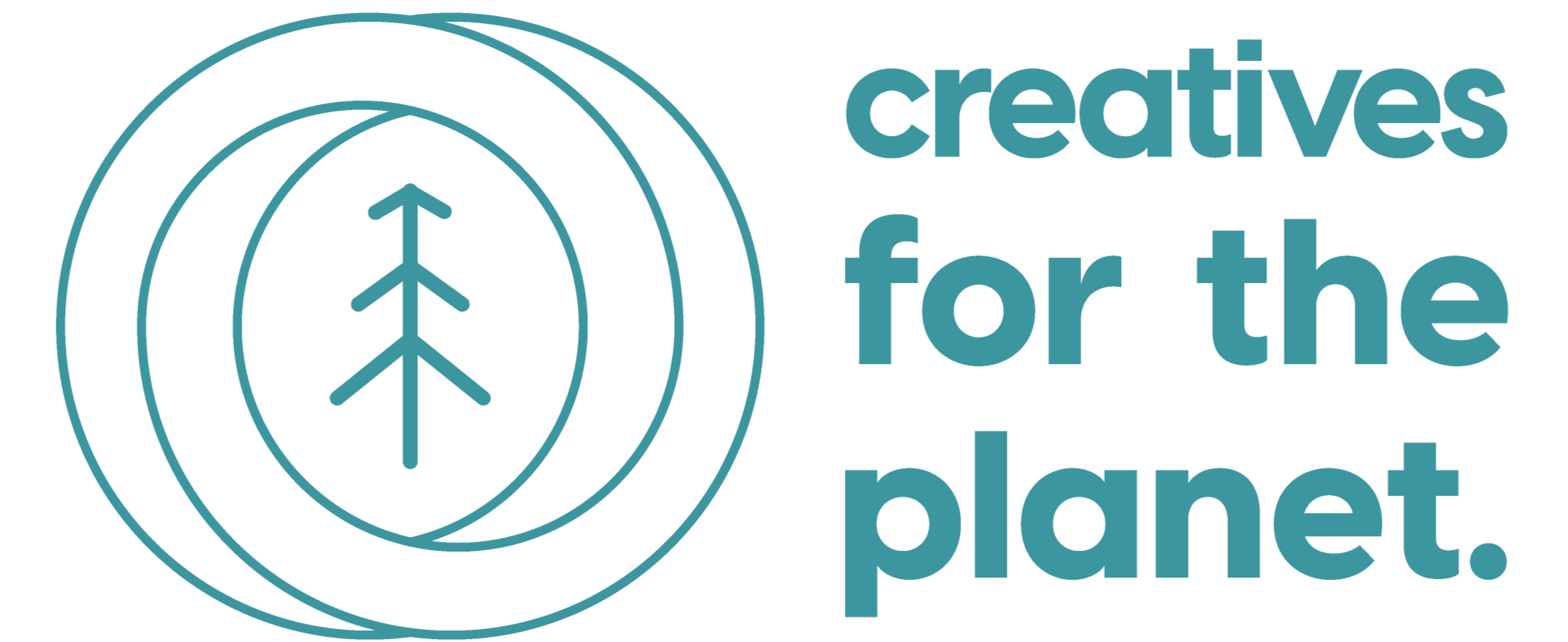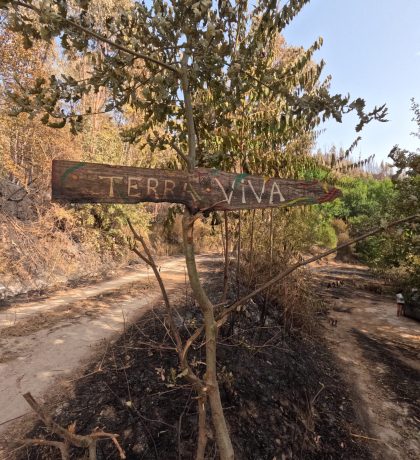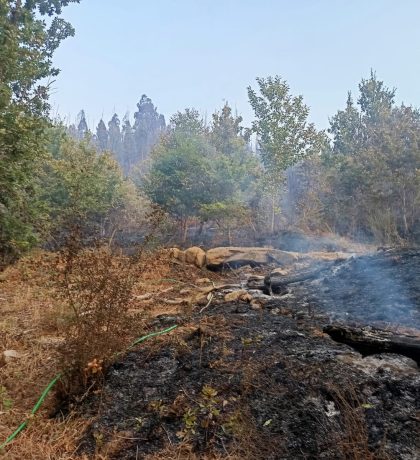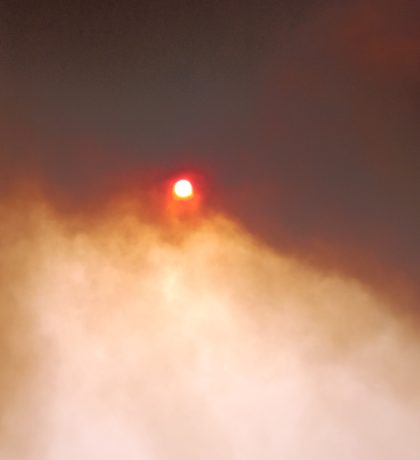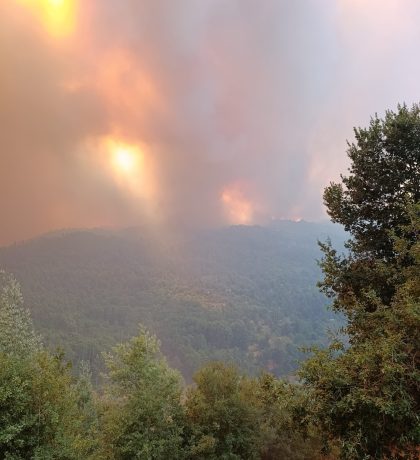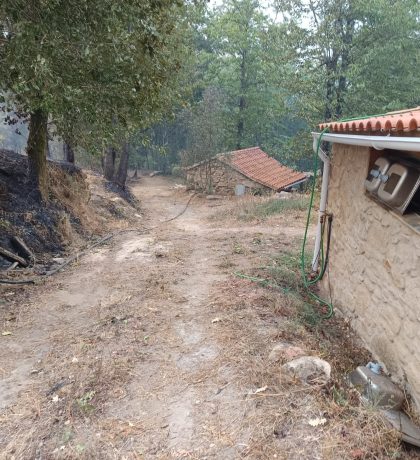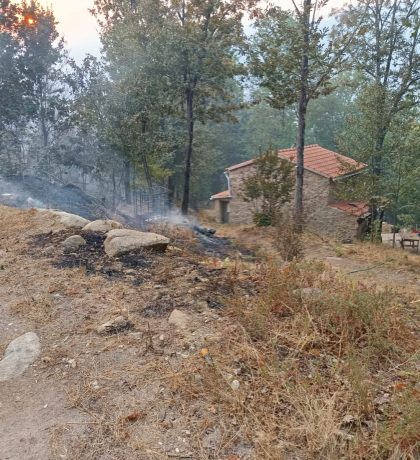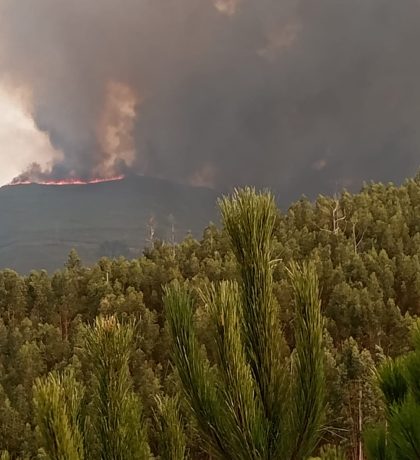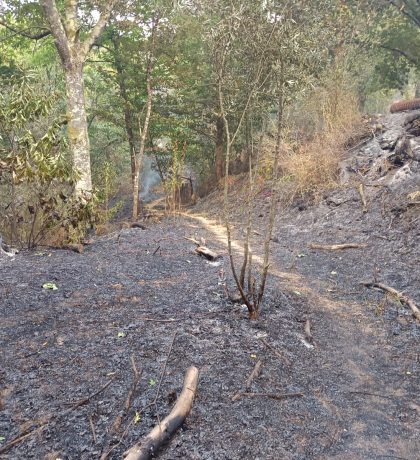CENTRAL PORTUGAL — The fire came from kilometers away, a wall of smoke and flame advancing across the hills. By the time it reached Terra Viva, a piece of land, of our collaborators dedicated to education and ecological restoration in Portugal’s interior, there was little left to do but watch.
“No help arrived, no firefighters, nothing,” recalled Jorge, a member of the project. “We could only stand there as the fire consumed our land.”
Yet when the smoke cleared, something unexpected remained: the old oak and chestnut trees, tall and gnarled, were still alive. The stone houses still stood. Around them, vast plantations of eucalyptus and pine were reduced to ash.
“Luckily, we were semi-prepared,” Jorge said. “We had watered the houses, cleared the undergrowth. But it still feels like a miracle. Terra Viva is blessed.”
Armonia, another caretaker of the land, described it as both devastation and revelation. “We can see how a healthy forest is strong and resilient. The old trees all survived. The eucalyptus forests nearby burned down completely. This is our motivation to rebuild, to focus on conservation. We’ve seen and directly experienced the consequences of the abandonment of the countryside, the threats of climate change, interest of the paper industry, corporations in mining, and territorial needs for solar and eolic energy. The only real protection is a healthy ecosystem.”
Across the Iberian Peninsula, 2025 is already one of the worst fire seasons in decades. In Spain, more than 340,000 hectares have burned, closing sections of the Camino de Santiago and prompting the deployment of thousands of soldiers. Portugal has lost more than 200,000 hectares with fatal blazes sweeping through the northern districts of Trancoso and Arganil. Together, at least six people have died, including firefighters in both countries.
The European Union’s civil protection fleet has been called upon at record levels. Fire-fighting aircraft from Italy and Greece have been dispatched to Iberia, even as those same countries brace for their own peak fire weeks. Europe’s capacity to respond is being stretched thin.
Scientists say these fires are not anomalies. Europe is the fastest-warming continent, and the Mediterranean region is a hotspot for rising temperatures and longer, more intense droughts. The Intergovernmental Panel on Climate Change warns that extreme fire weather is set to become a persistent feature of southern Europe’s summers.
The landscape of Iberia has also shifted in ways that feed the flames. Over the past half-century, millions have left rural villages. Abandoned farmland has turned into thickets of shrubs and young forest. Meanwhile, industrial forestry has blanketed swaths of Portugal and Spain with eucalyptus and pine plantations. In Portugal, eucalyptus now covers about a quarter of the country’s forests.
This transformation has produced what fire experts call “continuous fuels” — forests and scrublands so dense that once a spark lands, flames can race unchecked across hills and valleys.
By contrast, the survivors at Terra Viva point to another model: old, diverse woodlands with open understories. These do not prevent fire altogether — under extreme heat and wind, almost nothing can — but they can slow its spread, lower its intensity, and protect what lies within.
“Healthy forests aren’t fireproof,” said one Portuguese ecologist. “But they are more fire-resilient. Structure and diversity matter.”
Politics of the flame
The fires have ignited not just landscapes but also political narratives.
In Spain, Prime Minister Pedro Sánchez has framed the crisis as evidence of climate change’s dangers and called for a State Pact on climate adaptation. The conservative opposition, the Partido Popular, accuses his government of hiding behind climate rhetoric while failing to provide enough firefighting resources. The far-right Vox party goes further, dismissing climate explanations and blaming “climate fanaticism” and the U.N.’s Agenda 2030 program.
In Portugal, the government under Prime Minister Luís Montenegro has declared a state of emergency and sought EU help. But the far-right Chega party claims that “most fires are arson” and calls for mandatory prison sentences and forced reforestation work. Fact-checkers say such claims exaggerate the role of intentional arson: official statistics show that while humans cause most ignitions, negligence and accidents far outweigh deliberate acts.
If the far right has turned Agenda 2030 into a villain, others question it for different reasons. Among academics, environmental thinkers, and some left-leaning critics, the charge is not that the U.N. framework goes too far — but that it does not go far enough.
“The Sustainable Development Goals are contradictory,” says Jason Hickel an economic anthropologist whose work focuses on inequality and ecology. “They commit governments to indefinite economic growth while also promising to reduce ecological impact. Both goals cannot be achieved at the same time.”
Similarly, author Naomi Klein has warned that sustainability frameworks risk becoming “neoliberalism in green clothing” — a way to signal progress while leaving the structures of fossil capitalism untouched.
These voices do not deny the reality of climate change; they insist that frameworks like Agenda 2030 are too soft, too voluntary, too easily greenwashed. In Portugal, rural sociologists add that such plans often emphasize technocratic “resilience” while ignoring the collapse of rural economies, which is precisely what leaves landscapes abandoned and fuels accumulating.
The result is a strange convergence: right-wing populists rail against Agenda 2030 as authoritarian overreach, while left critics dismiss it as insufficient window-dressing. One side denies the climate problem; the other insists the solutions offered are not nearly radical enough.
The implications reach beyond Portugal and Spain. Smoke has drifted into France and even northern Europe, degrading air quality. Tourism and rail transport have been disrupted. Insurers are sounding alarms about mounting losses. And as more EU states call for firefighting aircraft, the bloc’s rescEU fleet risks being overwhelmed in a summer where fires burn simultaneously across the continent.
And yet, in the ashes of Terra Viva, a fragile optimism persists.
“This is our motivation to build again,” Armonia said. “To focus on nature conservation. To prove that healthy ecosystems, where humans live in sync with the land, are our best defense.”
Experts agree. Sustainable fire prevention, they say, means moving from emergency suppression to year-round management: thinning overcrowded stands, using prescribed fire to reduce fuel loads, reviving grazing and agroforestry, and restoring resilient native woodlands like cork oak and chestnut.
The European Union’s Forest Strategy 2030 and the new Nature Restoration Law provide frameworks and funding, but implementation will depend on local communities and landowners.
At Terra Viva, the message is painfully clear. The fire destroyed much, but also revealed what endures. Old forests, cared for and connected, stood strong. The association now hopes its patch of green can be both sanctuary and example.
“Europe is burning,” Armonia said. “But we still have solutions. We can rethink, regrow, and create places where forests and people protect each other. That is our hope.”
If you would like to support the rebuilding of Terra Viva, we warmly welcome your donations — every contribution helps us bring life back to the land : https://gofund.me/03b378cb
Sources for reference
Reuters – Record Spanish wildfires close part of Camino de Santiago route
The Guardian – Wildfires rage in Spain and Portugal amid searing heat
IPCC AR6 Synthesis Report
Jason Hickel – The Problem with the SDGs
EU Forest Strategy 2030
EU Nature Restoration Law
